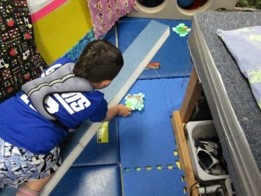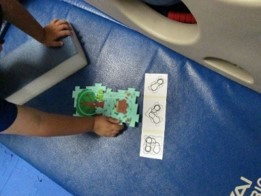 Graviception is described as the ability to appreciate the force of gravity as we move through space. Graviception develops from integration of sensory input including information from the vestibular, visual, and somatosensory systems. Research has now shown that graviception provides a developmental basis for evolving concepts of spatial relations embedded in academic success. Curricular skills such as handwriting, math, geometry, history, geography, and fluency in reading rely heavily upon the ability to appreciate spatial concepts.
Graviception is described as the ability to appreciate the force of gravity as we move through space. Graviception develops from integration of sensory input including information from the vestibular, visual, and somatosensory systems. Research has now shown that graviception provides a developmental basis for evolving concepts of spatial relations embedded in academic success. Curricular skills such as handwriting, math, geometry, history, geography, and fluency in reading rely heavily upon the ability to appreciate spatial concepts.
“It has been hypothesized that cognitive functions related to the processing of vestibular input also have “critical periods” with limited developmental windows when their underlying brain structures establish long-lasting connectivity with repercussions for life.” Spatial navigation, adaptive posturomotor function, and the ability to process relations between background environmental cues should therefore be considered developmental markers for pediatric caregivers.
Clinical observations of spatial navigation skills should include:
- Gaze stabilization
- Presence of frequent bruises
- Ability to maintain equilibrium with stable head on neck and body posture during immobility
- Relative movements among body parts
- Fluency of interaction with the environment (pushing, reaching, catching, ducking/avoidance, etc.)
- Spatial representation of a geocentric frame of reference (inside/outside, above/below, in front/back of, under/over
- Imitation of postures
When introduced to this game, his first question was “How?” as the youngster began to balance his body on the balance beam. Organizing input from internal representation of body scheme, and planning for sequences of limb and postural moves along the balance beam without loss of equilibrium were initially paramount in his thinking. His ability to move forward and then backward along the beam required integration of somatosensory input from vestibular, proprioceptive, and visual systems. A cognitive load was then superimposed by showing him a track layout for a pathway, and having him select the puzzle squares used to construct the pathway for the ladybug. In this way, we were able to see if he was able to incorporate the language of spatial navigation as he moved and turned along the balance beam in search of puzzle pieces.
We could tell that this youngster was internalizing the language of spatial orientation while he balanced himself, moved forward, backward, and turned around to locate puzzle parts that matched the lady bug’s pathway by what he was saying as he moved along the balance beam. As expected, he initial selection was inaccurate, but as he placed the puzzle part down, he was able to say what curves matched and which ones didn’t. We were pleased to see that the activity facilitated emergence of self-monitoring skills. As he subsequently made correct choices and moved over to the table to try out the pathway, we were please to see that he was actually translating his concrete experience of abstract spatial concepts into spatial language needed for success in school tasks such as handwriting, spelling, and math.




Comments are closed.